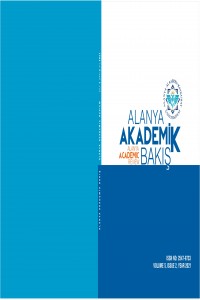Abstract
Bu araştırmanın amacı Wang ve Wang (2019) tarafından geliştirilen Yapay Zeka Kaygı Ölçeğinin Türkçeye uyarlanmasıdır. Yapay zeka alanındaki çalışmaların hızla ilerlemesi ve çeşitli sektörlerde farklı uygulamaların geliştirilmesiyle birlikte insanların iş ve gelecek kaygılarının arttığı vurgulanmaktadır. Teknolojinin çok hızlı geliştiği günümüz Endüstri 4.0 döneminde çalışanların yapay zeka kaygısının belirlenmesi ve uyumunun sağlanması önem arz etmektedir. Bu uyum sürecini daha iyi yönetmek için gelecekteki araştırmalarda kullanılmak üzere Yapay Zeka Kaygı Ölçeğinin Türkçeye adaptasyonu önemli olarak değerlendirilmektedir. Araştırma Farklı yükseköğrenim kurumlarında eğitim alan 490 katılımcıdan oluşana üç farklı örneklem ile yürütüldü. Ölçek uyarlama süreci Brislin geri çeviri prosedürü doğrultusunda izlendi. Araştırma bir ölçek uyarlama çalışması olduğu için öncelikle İngilizce ve Türkçe diline hâkim akademisyenler tarafından dil geçerliği yapıldı. Dil geçerliği sağlandıktan sonra ölçeğin yapı geçerliği ve güvenirlik analizi incelendi. Ölçeğin yapı geçerliğini belirlemek için Keşfedici Faktör Analiz (KFA) ve Doğrulayıcı Faktör Analizi (DFA) yapıldı. KMO 0.892 ve Barlett testi χ² değeri ise 2847.749(p=.000) olarak bulunmuştur. KFA’dan elde edilen madde-faktör yapısının doğrulayıcı faktör analizi (DFA) ile model uyumu test edilmiştir. Buna göre Yapay Zeka Kaygı Ölçeği’nin dört faktörlü yapısının doğrulandığı görülmüştür. Uyum iyiliği değerleri (Δχ² = 260.120. sd= 99 χ²/sd=2.627, NFI=.923, CFI=.950. RFI=.906, IFI=.951, TLI=,940. RMSEA= .078, p=.000) kabul edilebilir aralıklarda bulunmuştur. Ölçeğin güvenirliğini belirlemek için yapılan toplam iç tutarlılık katsayısının α=.937, Öğrenme boyutunun α=.948, İş Değiştirme boyutunun α=.895, Sosyoteknik Körlük boyutunun α=.875 ve Yapay Zeka (YZ)Yapılandırması boyutunun ise α=.950 olduğu ve ölçeğin iç tutarlılığa sahip olduğu bulunmuştur. Yapay Zeka Kaygı Ölçeğinin Türkçe formunun 16 madde ve 4 boyuttan oluştuğu saptanmıştır. Elde edilen tüm bu bulgular Yapay Zeka Kaygı Ölçeğinin Türkçe Formunun kabul edilebilir değerlerde güvenilir ve geçerli bir ölçme aracı olduğu söylenebilir.
Thanks
Değerlendirmeleriniz için şimdiden teşekkür ederim.
References
- WANG, Y.-Y., & WANG, Y.-S. (2019). Development and validation of an artificial intelligence anxiety scale: an initial application in predicting motivated learning behavior. Interactive Learning Environments, 1–16. https://doi.org/10.1080/10494820.2019.1674887
Abstract
The aim of this study is to adapt the Artificial Intelligence Anxiety Scale developed by Wang and Wang (2019) into Turkish. It is emphasized that the anxiety of managers and business have increased due to the rapid progress of the studies in the field of artificial intelligence and the development of different applications in various sectors. Todays, Industry 4.0 period, where technology is developing very rapidly, it is important to determine the artificial intelligence anxiety of the employees and to ensure their harmony. The adaptation of the Artificial Intelligence Anxiety Scale to Turkish is considered important to better manage this adaptation process and to be used in future research. This research was conducted with three different samples of 490 participants studying at different higher education institutions. The scale adaptation process was followed by Brislin back translation procedure. Since the study was a scale adaptation study, language validation was first performed by academicians who have command of English and Turkish. After the language validity was provided, the construct validity and reliability analysis of the scale were examined. Exploratory Factor Analysis (KFA) and Confirmatory Factor Analysis (CFA) were performed to determine the construct validity of the scale. KMO was found as 0.892 and Barlett test χ² value was found as 2847.749 (p =. 000). Model fit was tested with confirmatory factor analysis (CFA) of item-factor structure obtained from KFA. Accordingly, it was seen that the four-factor structure of the Artificial Intelligence Anxiety Scale was confirmed. Goodness of fit values (Δχ² = 260.120. sd = 99 χ² / sd = 2.627, NFI = .923, CFI = .950. RFI = .906, IFI = .951, TLI = .940. RMSEA = .078, p = .000) have been found within acceptable ranges. The total internal consistency coefficient to determine the reliability of the scale is α = .937, the learning dimension is α = .948, the job replacement dimension is α = .895, the sociotechnical blindness dimension is α = .875 and the artificial intelligence (AI) configuration dimension is α = .950. and the scale was found to have internal consistency. It was determined that the Turkish version of the Artificial Intelligence Anxiety Scale consists of 16 items and 4 dimensions. With all these findings, it can be said that the Turkish Form of the Artificial Intelligence Anxiety Scale is a reliable and valid measurement tool at acceptable values.
Keywords
Artificial Intelligence Anxiety Scale Scale Adaptation Artificial Intelligence Job replacement Industry 4.0
References
- WANG, Y.-Y., & WANG, Y.-S. (2019). Development and validation of an artificial intelligence anxiety scale: an initial application in predicting motivated learning behavior. Interactive Learning Environments, 1–16. https://doi.org/10.1080/10494820.2019.1674887
Details
| Primary Language | Turkish |
|---|---|
| Subjects | Communication and Media Studies |
| Journal Section | Makaleler |
| Authors | |
| Publication Date | May 31, 2021 |
| Acceptance Date | April 9, 2021 |
| Published in Issue | Year 2021 Volume: 5 Issue: 2 |


